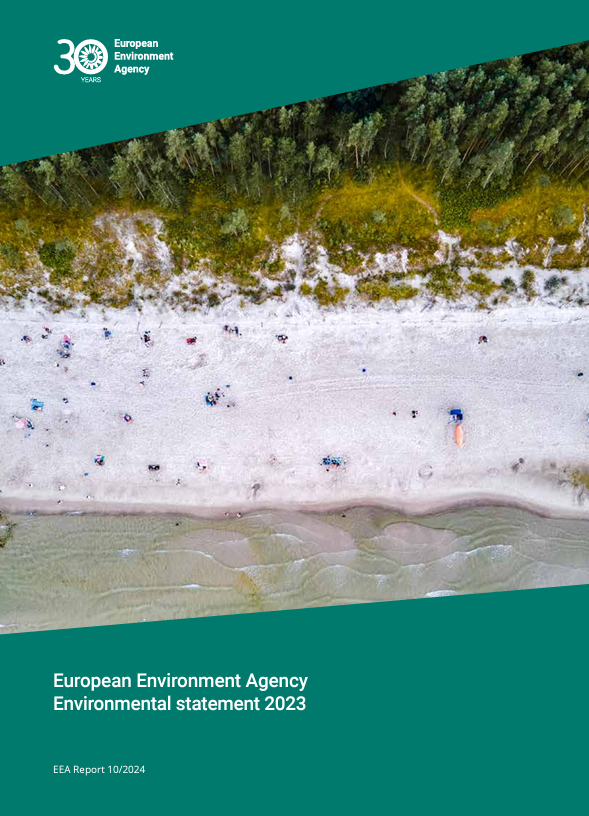All official European Union website addresses are in the europa.eu domain.
See all EU institutions and bodiesEEA Report 10/2024
The EEA′s annual environmental statement report for 2023 conforms to requirements stipulated in the EU Eco-Management and Audit Scheme (EMAS) Regulation and takes into account the sectoral reference document for the public administration sector. The report contains information on the EEA′s environmental management system (EMS), its environmental performance in 2023, and the updated environmental targets and an action plan for 2024.
EN PDF: TH-01-24-003-EN-N - ISBN: 978-92-9480-679-6 - ISSN: 1977-8449 - doi: 10.2800/7636500
Key messages
- The EEA achieved all its environmental targets for 2023, except in the area of water.
- The EEA’s environmental performance in 2023 showed a rebound effect compared to the years still influenced by the COVID-19 pandemic. Most of the environmental performance indicators, such as energy consumption and water consumption showed an increase compared to 2022. Areas such as paper consumption, waste reduction and sorting continued to improve.
- The EEA′s electricity provider guarantees that an amount (100 %) of the EEA's electricity is produced from renewable resources in Europe. Over the last 3 years, an increase in staff related electricity consumption (total and per full-time equivalent (FTE)) was observed, but it was still below the pre-pandemic level. The systematic use of energy efficient docking stations, as well as the teleworking practices of staff and the deployment of the newly refurbished areas of the building may have slightly mitigated the overall increase in staff. On the other hand, energy consumption linked to heating decreased, which could be associated with the application of EU and Danish guidance for limiting indoor heating, as well as the closure of the floors undergoing refurbishment. Despite not being accounted for directly in the EEA′s energy consumption, an increase was seen in the electricity consumption (+12%) of the EEA′s IT server infrastructure, which has been co-located in an external, energy efficient data centre since 2022.
- Paper consumption continued to decrease, with the ongoing digitalisation of administrative workflows and the continued fall in printed materials. The application of the zero-print policy for EEA publications continued, with no discernible negative impact on outreach and the visibility of EEA products.
- A new target for water consumption was introduced in the 2023 environmental management programme. The target was not achieved. Water consumption showed continuous growth over the last 2 years, peaking far above the pre-pandemic level. Water use in the canteen accounts for 1/3 of overall consumption and may explain part of this increase as the consumption almost doubled in 2023. The increase in staff, as well as a higher occupancy of the premises with the opening of newly refurbished floors in Kongens Nytorv 6 (KN6) and the increased use of the canteen services may explain this jump. The newly renovated f loors include green walls that require extra watering compared to the previous setup.
- Regarding waste, trends in waste generated and the rate of waste collected as recyclables are improving. The EEA′s separate collection performance increased over time with the gradual introduction of more waste materials collected separately (44%).
- In May 2023, separate collection of several new waste fractions was introduced, following Danish national requirements. As part of the EMAS activities for 2023, a new waste sorting system was introduced on all floors of the EEA building, with accompanying information for EEA staff. The data for 2023 on separately collected waste fractions indicated an increase in the amounts of plastics, metals, cardboard and glass collected compared to 2022, indicating that this new system seems to be taking effect. Thanks to the donation policy, a significant share of old canteen porcelain and cutlery has been donated.
- A reduced budget for business travel and visitor meetings, alongside the EEA′s climate neutrality pledge and the growing use of videoconferencing have kept 2023 greenhouse gas emissions from staff and visitor travel at a relatively low level. Staff related travel, as well as meetings on the EEA premises have, to some extent, been replaced by videoconferencing and blended meetings. However, maintaining this low level of emissions appears to be a key challenge for the organisation.

